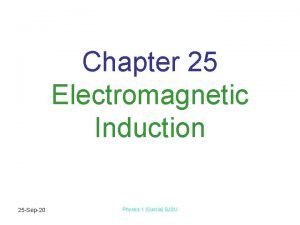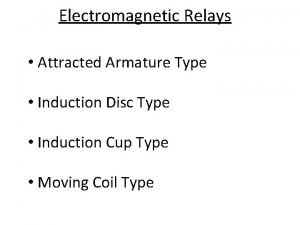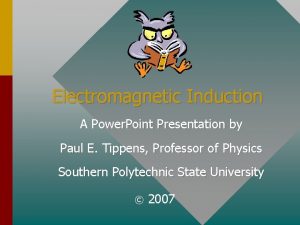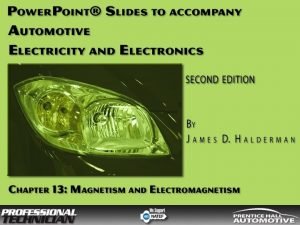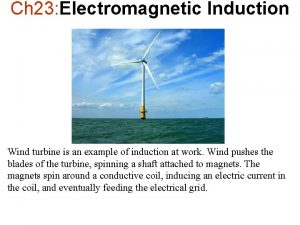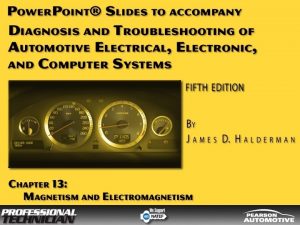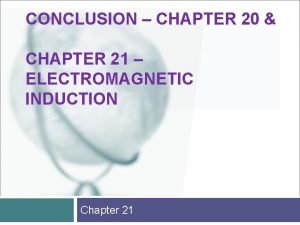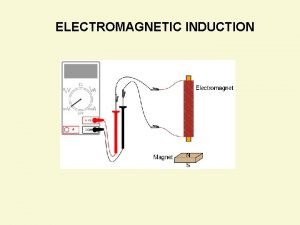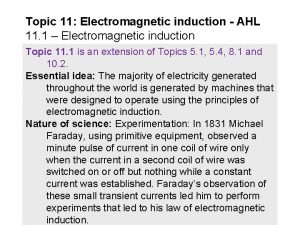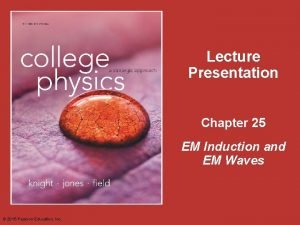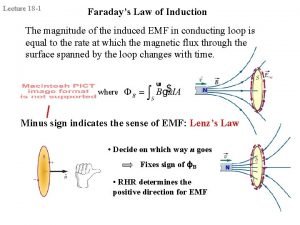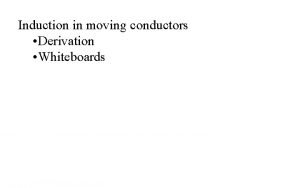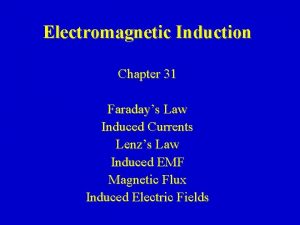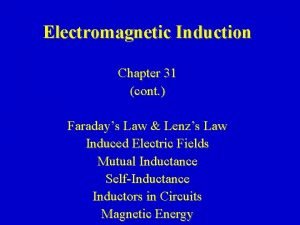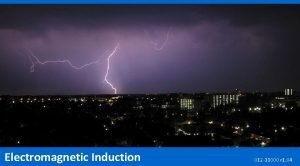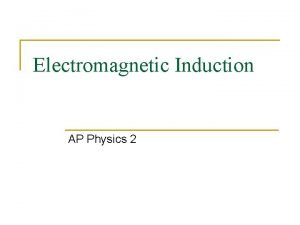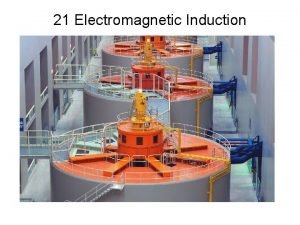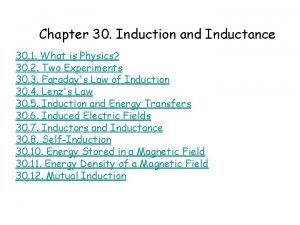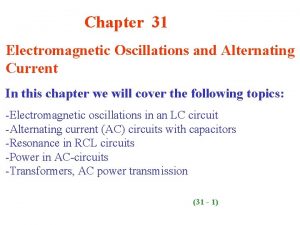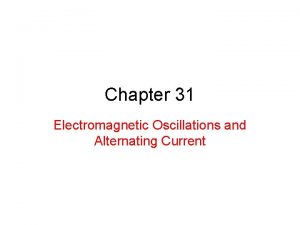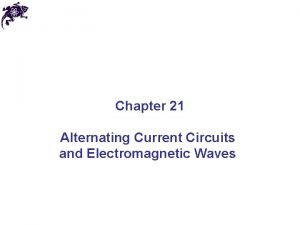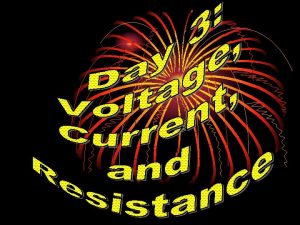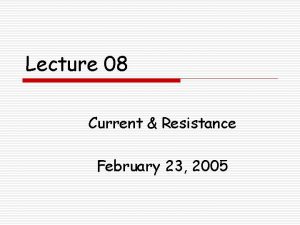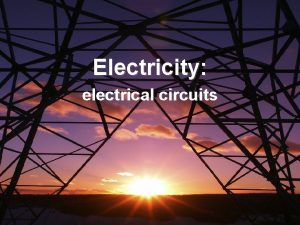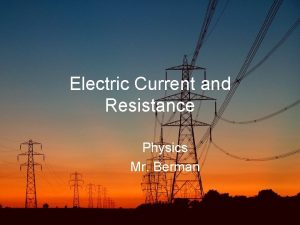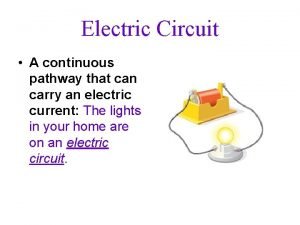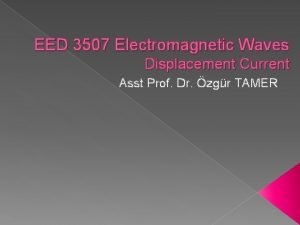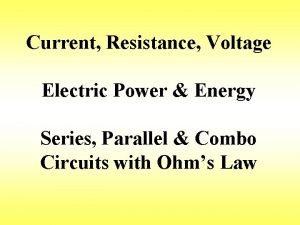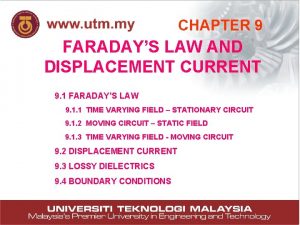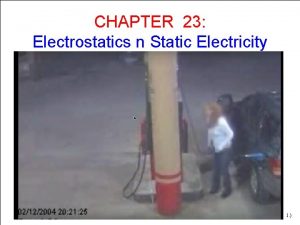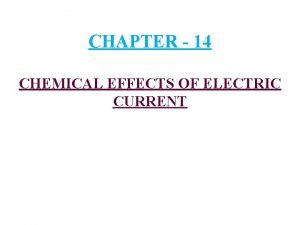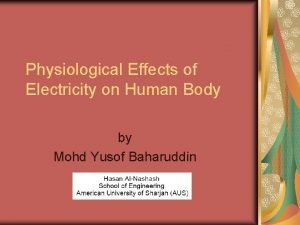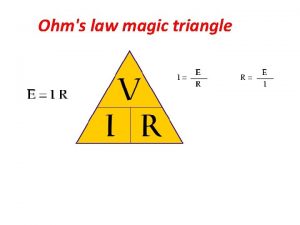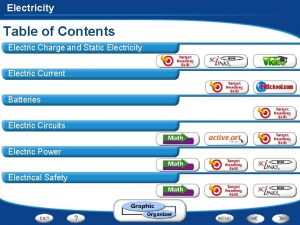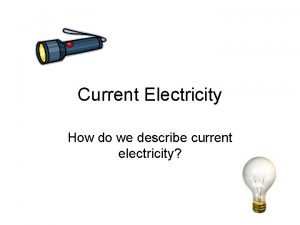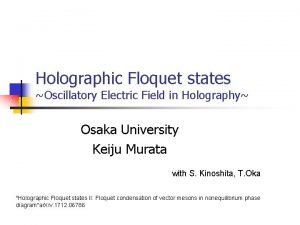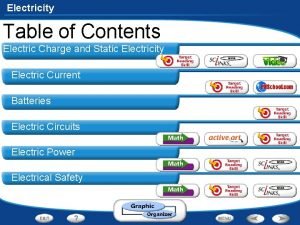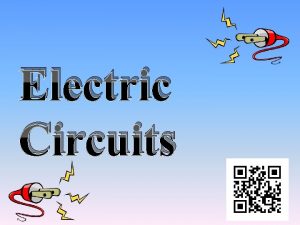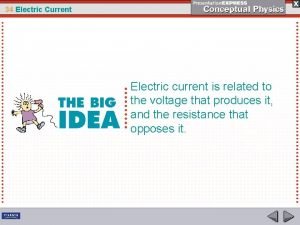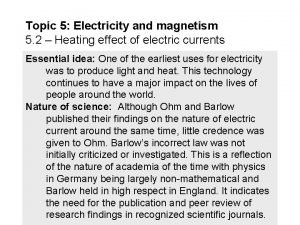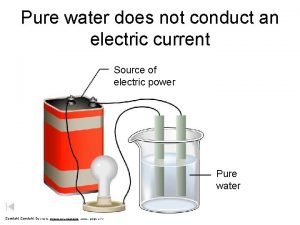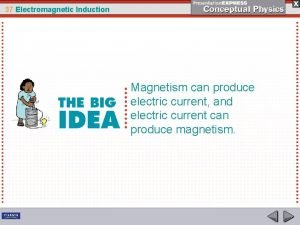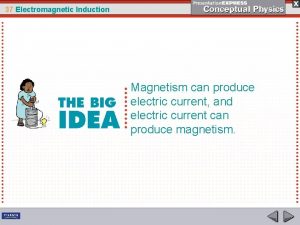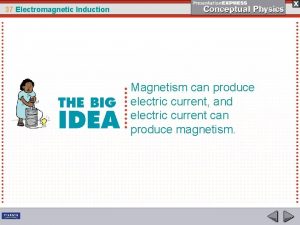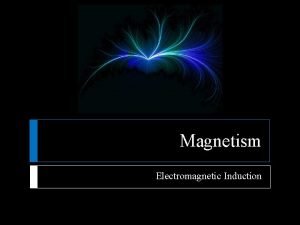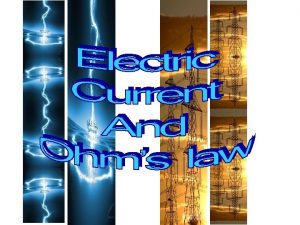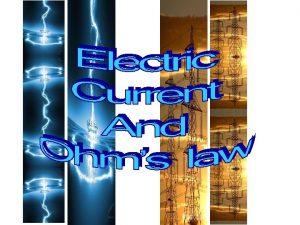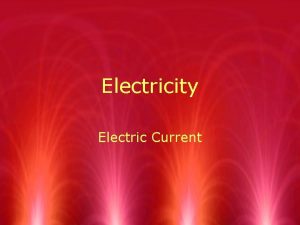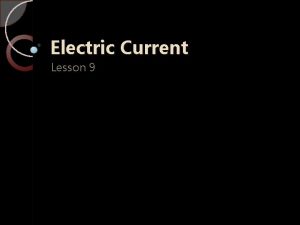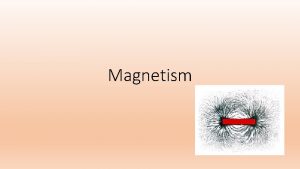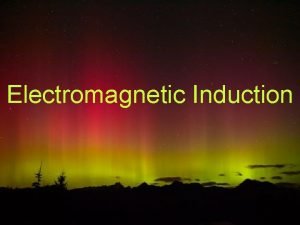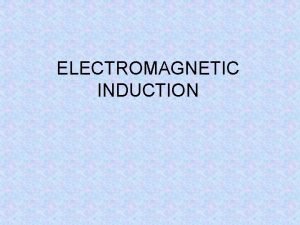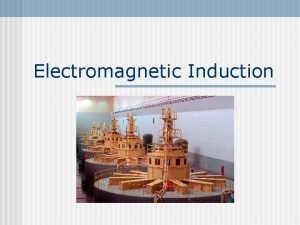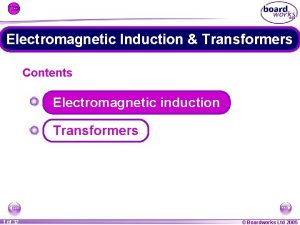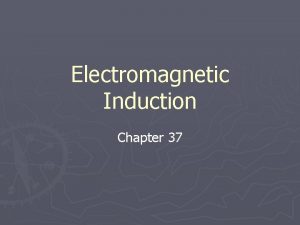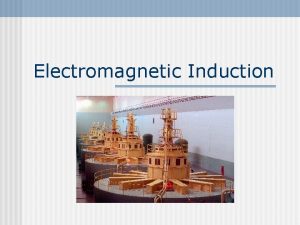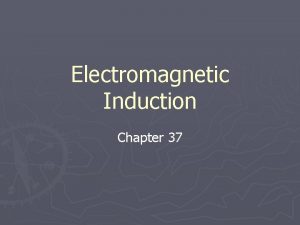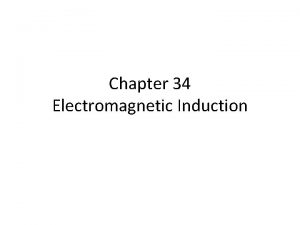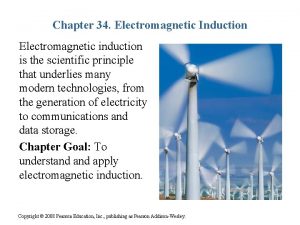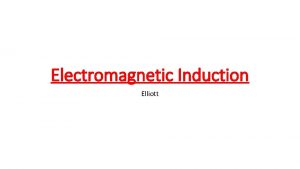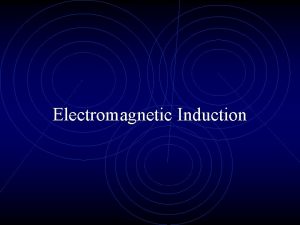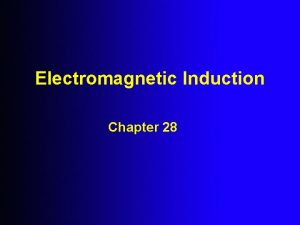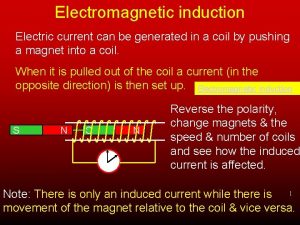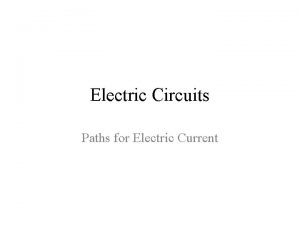37 Electromagnetic Induction Magnetism can produce electric current

























































- Slides: 57

37 Electromagnetic Induction Magnetism can produce electric current, and electric current can produce magnetism.

37 Electromagnetic Induction In 1831, two physicists, Michael Faraday in England Joseph Henry in the United States, independently discovered that magnetism could produce an electric current in a wire. Their discovery was to change the world by making electricity so commonplace that it would power industries by day and light up cities by night.

37 Electromagnetic Induction 37. 1 Electromagnetic Induction Electric current can be produced in a wire by simply moving a magnet into or out of a wire coil.

37 Electromagnetic Induction 37. 1 Electromagnetic Induction No battery or other voltage source was needed to produce a current—only the motion of a magnet in a coil or wire loop. Voltage was induced by the relative motion of a wire with respect to a magnetic field.

37 Electromagnetic Induction 37. 1 Electromagnetic Induction The production of voltage depends only on the relative motion of the conductor with respect to the magnetic field. Voltage is induced whether the magnetic field moves past a conductor, or the conductor moves through a magnetic field. The results are the same for the same relative motion.

37 Electromagnetic Induction 37. 1 Electromagnetic Induction The amount of voltage induced depends on how quickly the magnetic field lines are traversed by the wire. • Very slow motion produces hardly any voltage at all. • Quick motion induces a greater voltage. Increasing the number of loops of wire that move in a magnetic field increases the induced voltage and the current in the wire. Pushing a magnet into twice as many loops will induce twice as much voltage.

37 Electromagnetic Induction 37. 1 Electromagnetic Induction Twice as many loops as another means twice as much voltage is induced. For a coil with three times as many loops, three times as much voltage is induced.

37 Electromagnetic Induction 37. 1 Electromagnetic Induction We don’t get something (energy) for nothing by simply increasing the number of loops in a coil of wire. Work is done because the induced current in the loop creates a magnetic field that repels the approaching magnet. If you try to push a magnet into a coil with more loops, it requires even more work.

37 Electromagnetic Induction 37. 1 Electromagnetic Induction Work must be done to move the magnet. a. Current induced in the loop produces a magnetic field (the imaginary yellow bar magnet), which repels the bar magnet.

37 Electromagnetic Induction 37. 1 Electromagnetic Induction Work must be done to move the magnet. a. Current induced in the loop produces a magnetic field (the imaginary yellow bar magnet), which repels the bar magnet. b. When the bar magnet is pulled away, the induced current is in the opposite direction and a magnetic field attracts the bar magnet.

37 Electromagnetic Induction 37. 1 Electromagnetic Induction The law of energy conservation applies here. The force that you exert on the magnet multiplied by the distance that you move the magnet is your input work. This work is equal to the energy expended (or possibly stored) in the circuit to which the coil is connected.

37 Electromagnetic Induction 37. 1 Electromagnetic Induction If the coil is connected to a resistor, more induced voltage in the coil means more current through the resistor. That means more energy expenditure. Inducing voltage by changing the magnetic field around a conductor is electromagnetic induction.

37 Electromagnetic Induction 37. 1 Electromagnetic Induction How can you create a current using a wire and a magnet?

37 Electromagnetic Induction 37. 2 Faraday’s Law Faraday’s law states that the induced voltage in a coil is proportional to the product of the number of loops, the cross-sectional area of each loop, and the rate at which the magnetic field changes within those loops.

37 Electromagnetic Induction 37. 2 Faraday’s Law Faraday’s law describes the relationship between induced voltage and rate of change of a magnetic field: The induced voltage in a coil is proportional to the product of the number of loops, the cross-sectional area of each loop, and the rate at which the magnetic field changes within those loops.

37 Electromagnetic Induction 37. 2 Faraday’s Law The current produced by electromagnetic induction depends upon • the induced voltage, • the resistance of the coil, and the circuit to which it is connected. For example, you can plunge a magnet in and out of a closed rubber loop and in and out of a closed loop of copper. The voltage induced in each is the same but the current is quite different—a lot in the copper but almost none in the rubber.

37 Electromagnetic Induction 37. 2 Faraday’s Law think! If you push a magnet into a coil connected to a resistor you’ll feel a resistance to your push. For the same pushing speed, why is this resistance greater in a coil with more loops?

37 Electromagnetic Induction 37. 2 Faraday’s Law think! If you push a magnet into a coil connected to a resistor you’ll feel a resistance to your push. For the same pushing speed, why is this resistance greater in a coil with more loops? Answer: More work is required because more voltage is induced, producing more current in the resistor and more energy transfer. When the magnetic fields of two magnets overlap, the two magnets are either forced together or forced apart. When one of the fields is induced by motion of the other, the polarity of the fields is always such as to force the magnets apart. Inducing more current in more coils increases the induced magnetic field and the resistive force.

37 Electromagnetic Induction 37. 2 Faraday’s Law What does Faraday’s law state?

37 Electromagnetic Induction 37. 5 Transformers A transformer works by inducing a changing magnetic field in one coil, which induces an alternating current in a nearby second coil.

37 Electromagnetic Induction 37. 5 Transformers Consider a pair of coils, side by side, one connected to a battery and the other connected to a galvanometer. It is customary to refer to the coil connected to the power source as the primary (input), and the other as the secondary (output).

37 Electromagnetic Induction 37. 5 Transformers As soon as the switch is closed in the primary and current passes through its coil, a current occurs in the secondary. When the primary switch is opened, a surge of current again registers in the secondary but in the opposite direction. Whenever the primary switch is opened or closed, voltage is induced in the secondary circuit.

37 Electromagnetic Induction 37. 5 Transformers The magnetic field that builds up around the primary extends into the secondary coil. Changes in the magnetic field of the primary are sensed by the nearby secondary. These changes of magnetic field intensity at the secondary induce voltage in the secondary, in accord with Faraday’s law.

37 Electromagnetic Induction 37. 5 Transformers If we place an iron core inside both coils, alignment of its magnetic domains intensifies the magnetic field within the primary. The magnetic field is concentrated in the core, which extends into the secondary, so the secondary intercepts more field change. The galvanometer will show greater surges of current when the switch of the primary is opened or closed.

37 Electromagnetic Induction 37. 5 Transformers Instead of opening and closing a switch to produce the change of magnetic field, an alternating current can power the primary. Then the rate of magnetic field changes in the primary (and in the secondary) is equal to the frequency of the alternating current. Now we have a transformer, a device for increasing or decreasing voltage through electromagnetic induction.

37 Electromagnetic Induction 37. 5 Transformers If the iron core forms a complete loop, guiding all magnetic field lines through the secondary, the transformer is more efficient. All the magnetic field lines within the primary are intercepted by the secondary.

37 Electromagnetic Induction 37. 5 Transformers Voltages may be stepped up or stepped down with a transformer. Suppose the primary consists of one loop connected to a 1 -V alternating source. • Consider the arrangement of a one-loop secondary that intercepts all the changing magnetic field lines of the primary. • Then a voltage of 1 V is induced in the secondary.

37 Electromagnetic Induction 37. 5 Transformers If another loop is wrapped around the core, the induced voltage will be twice as much, in accord with Faraday’s law. If the secondary has a hundred times as many turns as the primary, then a hundred times as much voltage will be induced. This arrangement of a greater number of turns on the secondary than on the primary makes up a stepup transformer. Stepped-up voltage may light a neon sign or operate the picture tube in a television receiver.

37 Electromagnetic Induction 37. 5 Transformers a. 1 V induced in the secondary equals the voltage of the primary.

37 Electromagnetic Induction 37. 5 Transformers a. b. 1 V induced in the secondary equals the voltage of the primary. 1 V is induced in the added secondary also because it intercepts the same magnetic field change from the primary.

37 Electromagnetic Induction 37. 5 Transformers a. b. c. 1 V induced in the secondary equals the voltage of the primary. 1 V is induced in the added secondary also because it intercepts the same magnetic field change from the primary. 2 V is induced in a single two-turn secondary.

37 Electromagnetic Induction 37. 5 Transformers If the secondary has fewer turns than the primary, the alternating voltage in the secondary will be lower than that in the primary. The voltage is said to be stepped down. If the secondary has half as many turns as the primary, then only half as much voltage is induced in the secondary.

37 Electromagnetic Induction 37. 5 Transformers The relationship between primary and secondary voltages with respect to the relative number of turns is

37 Electromagnetic Induction 37. 5 Transformers A practical transformer uses many coils. The relative numbers of turns in the coils determines how much the voltage changes.

37 Electromagnetic Induction 37. 5 Transformers Power You don’t get something for nothing with a transformer that steps up the voltage, for energy conservation is always in control. The transformer actually transfers energy from one coil to the other. The rate at which energy is transferred is the power. The power used in the secondary is supplied by the primary.

37 Electromagnetic Induction 37. 5 Transformers The primary gives no more power than the secondary uses. If the slight power losses due to heating of the core are neglected, then the power going in equals the power coming out. Electric power is equal to the product of voltage and current: (voltage × current)primary = (voltage × current)secondary

37 Electromagnetic Induction 37. 5 Transformers If the secondary has more voltage, it will have less current than the primary. If the secondary has less voltage, it will have more current than the primary.

37 Electromagnetic Induction 37. 5 Transformers This transformer lowers 120 V to 6 V or 9 V. It also converts AC to DC by means of a diode that acts as a one-way valve.

37 Electromagnetic Induction 37. 5 Transformers think! When the switch of the primary is opened or closed, the galvanometer in the secondary registers a current. But when the switch remains closed, no current is registered on the galvanometer of the secondary. Why?

37 Electromagnetic Induction 37. 5 Transformers think! When the switch of the primary is opened or closed, the galvanometer in the secondary registers a current. But when the switch remains closed, no current is registered on the galvanometer of the secondary. Why? Answer: A current is only induced in a coil when there is a change in the magnetic field passing through it. When the switch remains in the closed position, there is a steady current in the primary and a steady magnetic field about the coil.

37 Electromagnetic Induction 37. 5 Transformers think! If the voltage in a transformer is stepped up, then the current is stepped down. Ohm’s law says that increased voltage will produce increased current. Is there a contradiction here, or does Ohm’s Law not apply to transformers?

37 Electromagnetic Induction 37. 5 Transformers think! If the voltage in a transformer is stepped up, then the current is stepped down. Ohm’s law says that increased voltage will produce increased current. Is there a contradiction here, or does Ohm’s Law not apply to transformers? Answer: Ohm’s law still holds, and there is no contradiction. The voltage induced across the secondary circuit, divided by the load (resistance) of the secondary circuit, equals the current in the secondary circuit. The current is stepped down in comparison with the larger current that is drawn in the primary circuit.

37 Electromagnetic Induction 37. 5 Transformers How does a transformer work?

37 Electromagnetic Induction 37. 7 Induction of Electric and Magnetic Fields Electromagnetic induction has thus far been discussed in terms of the production of voltages and currents. The more fundamental way to look at it is in terms of the induction of electric fields. The electric fields, in turn, give rise to voltages and currents.

37 Electromagnetic Induction 37. 7 Induction of Electric and Magnetic Fields Induction takes place whether or not a conducting wire or any material medium is present. Faraday’s law states that an electric field is created in any region of space in which a magnetic field is changing with time. The magnitude of the created electric field is proportional to the rate at which the magnetic field changes. The direction of the created electric field is at right angles to the changing magnetic field.

37 Electromagnetic Induction 37. 7 Induction of Electric and Magnetic Fields If electric charge happens to be present where the electric field is created, this charge will experience a force. • For a charge in a wire, the force could cause it to flow as current, or to push the wire to one side. • For a charge in the chamber of a particle accelerator, the force can accelerate the charge to high speeds.

37 Electromagnetic Induction 37. 7 Induction of Electric and Magnetic Fields There is a second effect, which is the counterpart to Faraday’s law. It is just like Faraday’s law, except that the roles of electric and magnetic fields are interchanged.

37 Electromagnetic Induction 37. 7 Induction of Electric and Magnetic Fields A magnetic field is created in any region of space in which an electric field is changing with time. • The magnitude of the magnetic field is proportional to the rate at which the electric field changes. • The direction of the created magnetic field is at right angles to the changing electric field.

37 Electromagnetic Induction 37. 7 Induction of Electric and Magnetic Fields How can an electric field create a magnetic field?

37 Electromagnetic Induction Assessment Questions 1. A voltage will be induced in a wire loop when the magnetic field within that loop a. changes. b. aligns with the electric field. c. is at right angles to the electric field. d. converts to magnetic energy.

37 Electromagnetic Induction Assessment Questions 1. A voltage will be induced in a wire loop when the magnetic field within that loop a. changes. b. aligns with the electric field. c. is at right angles to the electric field. d. converts to magnetic energy. Answer: A

37 Electromagnetic Induction Assessment Questions 2. If you change the magnetic field in a closed loop of wire, you induce in the loop a a. current. b. voltage. c. electric field. d. all of these

37 Electromagnetic Induction Assessment Questions 2. If you change the magnetic field in a closed loop of wire, you induce in the loop a a. current. b. voltage. c. electric field. d. all of these Answer: D

37 Electromagnetic Induction Assessment Questions 5. A step-up transformer in an electrical circuit can a. increase voltage. b. decrease energy. c. increase current. d. increase energy.

37 Electromagnetic Induction Assessment Questions 5. A step-up transformer in an electrical circuit can a. increase voltage. b. decrease energy. c. increase current. d. increase energy. Answer: A

37 Electromagnetic Induction Assessment Questions 6. To keep heat losses down when power is carried across the countryside, it is best that current in the wires is a. low. b. high. c. not too low and not too high. d. replaced with voltage.

37 Electromagnetic Induction Assessment Questions 6. To keep heat losses down when power is carried across the countryside, it is best that current in the wires is a. low. b. high. c. not too low and not too high. d. replaced with voltage. Answer: A
 Electric generator electromagnetic induction
Electric generator electromagnetic induction Induction disc relay
Induction disc relay Electromagnetic induction ppt
Electromagnetic induction ppt An ignition coil operates using the principle of
An ignition coil operates using the principle of Electromagnetic induction wind turbine
Electromagnetic induction wind turbine Two technicians are discussing electromagnetic induction
Two technicians are discussing electromagnetic induction Conclusion of electromagnetic induction
Conclusion of electromagnetic induction Electromagnetic induction
Electromagnetic induction Electromagnetic induction
Electromagnetic induction Faraday's law of electromagnetic induction ppt
Faraday's law of electromagnetic induction ppt Faraday's law
Faraday's law Faraday's law of electromagnetic induction ppt
Faraday's law of electromagnetic induction ppt Faraday's law of electromagnetic induction
Faraday's law of electromagnetic induction Faraday's law of electromagnetic induction
Faraday's law of electromagnetic induction Electromagnetic induction
Electromagnetic induction Flux linkage unit
Flux linkage unit Motional emf units
Motional emf units Electric field induction
Electric field induction Electromagnetic oscillations and alternating current
Electromagnetic oscillations and alternating current Electromagnetic oscillation pdf
Electromagnetic oscillation pdf Alternating current circuits and electromagnetic waves
Alternating current circuits and electromagnetic waves Line currents
Line currents Phase to phase voltage
Phase to phase voltage Semiconductor
Semiconductor Ac systems lesson 4
Ac systems lesson 4 Drift current and diffusion current
Drift current and diffusion current What is diffusion current and drift current
What is diffusion current and drift current Gm formula for mosfet
Gm formula for mosfet In a triangle connected source feeding a y connected load
In a triangle connected source feeding a y connected load Slideplayer
Slideplayer Drift current density unit
Drift current density unit Welding chapter 3
Welding chapter 3 Hazard based safety engineering
Hazard based safety engineering Non planar circuit
Non planar circuit Voltage drop def
Voltage drop def Electric current formula
Electric current formula Nature flow of electricity
Nature flow of electricity Chapter 23 electric current circuit happenings
Chapter 23 electric current circuit happenings Continuity equation for time varying field
Continuity equation for time varying field Electrical circuit analogy bakery
Electrical circuit analogy bakery Electric current unit
Electric current unit Pathway for carrying an electrical current.
Pathway for carrying an electrical current. Maximum displacement current
Maximum displacement current Current total in parallel circuit
Current total in parallel circuit Water
Water Current9
Current9 Conceptual physics chapter 23 electric current
Conceptual physics chapter 23 electric current Chemical effects of electric current
Chemical effects of electric current Physiological effects of electricity
Physiological effects of electricity Ohms law triange
Ohms law triange Electric current graphic organizer
Electric current graphic organizer Describe current
Describe current Boudary
Boudary Graphic organizer electric current
Graphic organizer electric current Draw and label the parts of basic electrical circuit
Draw and label the parts of basic electrical circuit Electric current
Electric current Heating effect of electric current
Heating effect of electric current Pure water is ________ for electric current.
Pure water is ________ for electric current.
